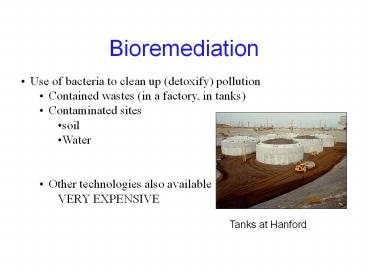Bioremediation PowerPoint PPT Presentation
Title: Bioremediation
1
Bioremediation
- Use of bacteria to clean up (detoxify) pollution
- Contained wastes (in a factory, in tanks)
- Contaminated sites
- soil
- Water
- Other technologies also available
- VERY EXPENSIVE
Tanks at Hanford
2
Bioremediation as Part of All Remediation
Technologies
3
Biodegradable Contaminants
- Bacteria have the natural ability to either grow
on toxic compounds or convert them to nontoxic
products - Classes of contaminants biodegraded
- Aromatics (toluene, xylene, benzene, phenol,
naphthalene) - Chlorinated aromatics (chlorobenzene, PCBs)
- Chlorinated solvents (chloroform,
trichloroethylene TCE) - These mostly involve enzymes called oxygenases
- Toxic metals (mercury)
- Other toxic metals can be taken up or
precipitated by cells - Cu, Co, Ni, Pb
- Not detoxified but can be removed more easily
4
Bioremediated Contaminants
5
Toluene degradation
TCE degradation
sMMO
T2MO
TOD
TCE epoxide
glyoxylate formate
chloral hydrate (not in whole cells)
sMMO
T2MO
(only with sMMO)
dichloroacetate
glyoxylate formate
The University of Minnesota Biocatalysis/Biodegrad
ation Database, http//umbbd.ahc.umn.edu/
- Organisms that contain these oxygenases will
detoxify toluene, TCE, and many other aromatic
and chlorinated toxic compounds
6
How Does Contamination Occur?
Spills or leaks sink into soil or water Get
transported by water movement
7
Contaminants get Dispersed
8
Plumes of Contaminants Remain
9
Plumes of Contaminants Remain
10
Natural Bioremediation
- Problem how to get bacteria to contaminant?
- Natural strains have biodegradative capability
- Can use in situ populations
- Need to increase total population by adding
substrates - Contaminated sites often very low nutrient
- Contain mixed populations of bacteria
- Gram of soil can contain 109 bacteria
- 1000s of types (tremendous diversity)
- Stimulate specific types with specific nutrients
- Example bacteria that grow on methane
accidentally detoxify TCE - add methane ---gt population increases --gtget
degradation of TCE - Oil spills just need to add a N and P source
11
What is Role for Engineering Bacteria?
- Increase substrates detoxified
- More individual compounds detoxified by one
strain - Simultaneous detoxification
- Increase rate of detoxification
- Increase expression
- Increase access to hydrophobic contaminants
- If contaminant can be accessed, it will not
persist - Hydrophobic contaminants persist
12
Access to Contaminants
No surfactants
With surfactants
Add genes to synthesize surfactants
13
Problems with Genetically Engineered
Microorganisms (GEMs)
- Dont survive in the environment
- Cant compete with existing bacteria
- Cloning in survival or persistence genes raises
regulatory issues - Few field trials of GEMs, identified strains that
can persist - Greatest potential of GEMs for bioremediation is
contained waste

